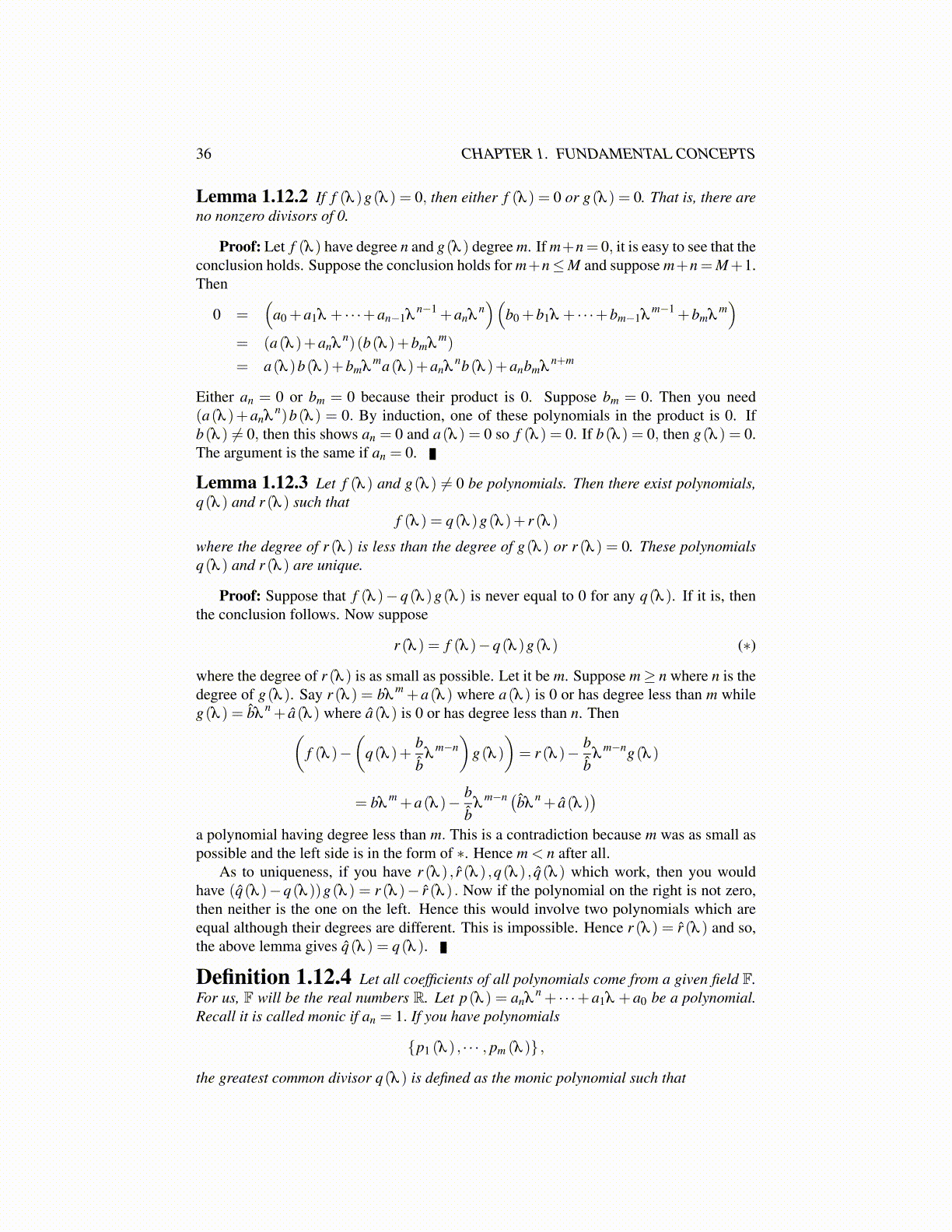
36 CHAPTER 1. FUNDAMENTAL CONCEPTS
Lemma 1.12.2 If f (λ )g(λ ) = 0, then either f (λ ) = 0 or g(λ ) = 0. That is, there areno nonzero divisors of 0.
Proof: Let f (λ ) have degree n and g(λ ) degree m. If m+n= 0, it is easy to see that theconclusion holds. Suppose the conclusion holds for m+n ≤ M and suppose m+n = M+1.Then
0 =(
a0 +a1λ + · · ·+an−1λn−1 +anλ
n)(
b0 +b1λ + · · ·+bm−1λm−1 +bmλ
m)
= (a(λ )+anλn)(b(λ )+bmλ
m)
= a(λ )b(λ )+bmλma(λ )+anλ
nb(λ )+anbmλn+m
Either an = 0 or bm = 0 because their product is 0. Suppose bm = 0. Then you need(a(λ )+anλ
n)b(λ ) = 0. By induction, one of these polynomials in the product is 0. Ifb(λ ) ̸= 0, then this shows an = 0 and a(λ ) = 0 so f (λ ) = 0. If b(λ ) = 0, then g(λ ) = 0.The argument is the same if an = 0.
Lemma 1.12.3 Let f (λ ) and g(λ ) ̸= 0 be polynomials. Then there exist polynomials,q(λ ) and r (λ ) such that
f (λ ) = q(λ )g(λ )+ r (λ )
where the degree of r (λ ) is less than the degree of g(λ ) or r (λ ) = 0. These polynomialsq(λ ) and r (λ ) are unique.
Proof: Suppose that f (λ )− q(λ )g(λ ) is never equal to 0 for any q(λ ). If it is, thenthe conclusion follows. Now suppose
r (λ ) = f (λ )−q(λ )g(λ ) (∗)
where the degree of r (λ ) is as small as possible. Let it be m. Suppose m ≥ n where n is thedegree of g(λ ). Say r (λ ) = bλ
m +a(λ ) where a(λ ) is 0 or has degree less than m whileg(λ ) = b̂λ
n + â(λ ) where â(λ ) is 0 or has degree less than n. Then(f (λ )−
(q(λ )+
bb̂
λm−n)
g(λ ))= r (λ )− b
b̂λ
m−ng(λ )
= bλm +a(λ )− b
b̂λ
m−n (b̂λn + â(λ )
)a polynomial having degree less than m. This is a contradiction because m was as small aspossible and the left side is in the form of ∗. Hence m < n after all.
As to uniqueness, if you have r (λ ) , r̂ (λ ) ,q(λ ) , q̂(λ ) which work, then you wouldhave (q̂(λ )−q(λ ))g(λ ) = r (λ )− r̂ (λ ) . Now if the polynomial on the right is not zero,then neither is the one on the left. Hence this would involve two polynomials which areequal although their degrees are different. This is impossible. Hence r (λ ) = r̂ (λ ) and so,the above lemma gives q̂(λ ) = q(λ ).
Definition 1.12.4 Let all coefficients of all polynomials come from a given field F.For us, F will be the real numbers R. Let p(λ ) = anλ
n + · · ·+a1λ +a0 be a polynomial.Recall it is called monic if an = 1. If you have polynomials
{p1 (λ ) , · · · , pm (λ )} ,
the greatest common divisor q(λ ) is defined as the monic polynomial such that